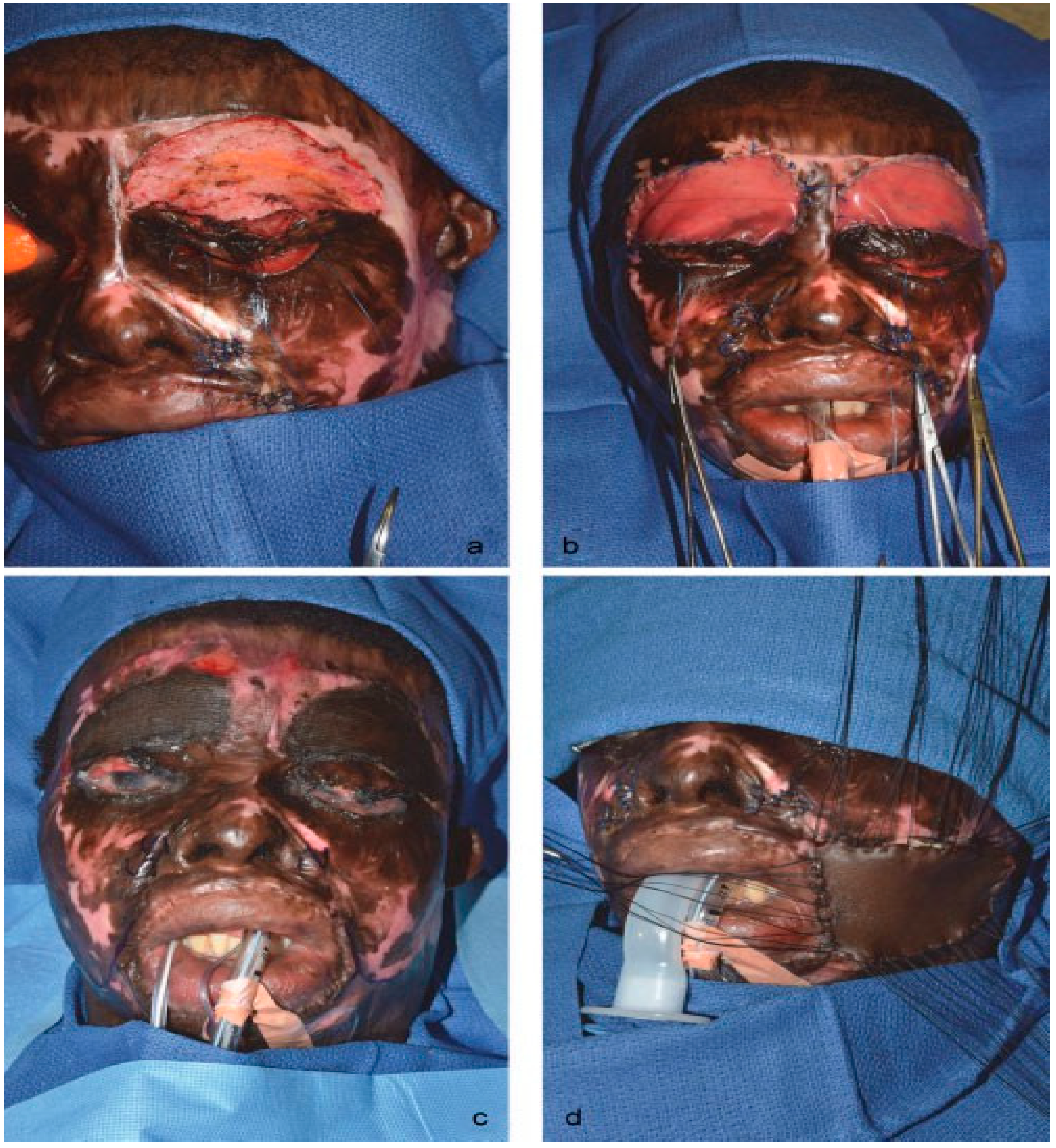Short Runs for a Long Slide: Principalization in Complex Facial Restoration after Acid Attack Burn Injury
Abstract
:Case Report
History
Initial Presentation and Physical Exam
Surgical Plan and Approach
- Phase 1: Eyesight preservation, brow remodeling, lid and mouth improvements (Principle 1: Correct the order of priorities; Principle 2: Return what is normal to normal position, and retain it there).
- Phase 2: Corneal transplant and scar remodeling (Principle 3: Know the ideal beautiful normal; Principle 4: Extend your abilities to do the most good).
- Phase 3: Sustain globe protection, oral competence, and overall facial appearance (Principle 5: Tissue losses should be replaced in kind; Principle 6: Reconstruction by units; Principle 7: Consider the secondary donor area; Principle 8: Learn to control tension).
Discussion
Conclusion
Conflicts of Interest
References
- Peck, M.; Molnar, J.; Swart, D. A global plan for burn prevention and care. Bull World Health Organ 2009, 87, 802–803. [Google Scholar] [CrossRef] [PubMed]
- World Health Organization. Available online: http://www.who.int/mediacentre/factsheets/fs365/en/ (accessed on 25 July 2018).
- Das, K.K.; Khondokar, M.S.; Quamruzzaman, M.; Ahmed, S.S.; Peck, M. Assault by burning in Dhaka, Bangladesh. Burns 2013, 39, 177–183. [Google Scholar] [CrossRef] [PubMed]
- Asaria, J.; Kobusingye, O.C.; Khingi, B.A.; Balikuddembe, R.; Gomez, M.; Beveridge, M. Acid burns from personal assault in Uganda. Burns 2004, 30, 78–81. [Google Scholar] [CrossRef] [PubMed]
- Das, K.K.; Olga, L.; Peck, M.; Morselli, P.G.; Salek, A.J.M. Management of acid burns: Experience from Bangladesh. Burns 2015, 41, 484–492. [Google Scholar] [CrossRef] [PubMed]
- Faga, A.; Scevola, D.; Mezzetti, M.G.; Scevola, S. Sulphuric acid burned women in Bangladesh: A social and medical problem. Burns 2000, 26, 701–709. [Google Scholar] [CrossRef] [PubMed]
- Guerrero, L. Burns due to acid assaults in Bogotá, Colombia. Burns 2013, 39, 1018–1023. [Google Scholar] [CrossRef] [PubMed]
- Young, R.C.; Ho, W.S.; Ying, S.Y.; Burd, A. Chemical assaults in Hong Kong: A 10-year review. Burns 2002, 28, 651–653. [Google Scholar] [CrossRef] [PubMed]
- Branday, J.; Arscott, G.D.; Smoot, E.C.; Williams, G.D.; Fletcher, P.R. Chemical burns as assault injuries in Jamaica. Burns 1996, 22, 154–155. [Google Scholar] [CrossRef] [PubMed]
- Mannan, A.; Ghani, S.; Clarke, A.; Butler, P.E. Cases of chemical assault worldwide: A literature review. Burns 2007, 33, 149–154. [Google Scholar] [CrossRef] [PubMed]
- Upton, J.; Janeka, I.; Ferraro, N. The whole is more than the sum of its parts: Aristotle, metaphysical. J Craniofac Surg 2014, 25, 59–63. [Google Scholar] [CrossRef]
- Millard, D.R., Jr. Principalization of Plastic Surgery, 1st ed.; Little Brown & Co.: Boston, MA, USA, 1986. [Google Scholar]
- Converse, J.M.; Smith, B. Repair of severe burn ectropion of the eyelids. Plast Reconstr Surg Transplant Bull 1959, 23, 21–26. [Google Scholar] [CrossRef] [PubMed]
- Yeşiloğlu, N.; Şirinoğlu, H.; Sarıcı, M.; Temiz, G.; Güvercin, E. A simple method for the treatment of cicatricial ectropion and eyelid contraction in patients with periocular burn: Vertical V-Y advancement of the eyelid. Burns 2014, 40, 1820–1821. [Google Scholar] [CrossRef] [PubMed]
- Vana, L.P.; Isaac, C.; Alonso, N. Treatment of extrinsic ectropion on burned face with facial suspension technique. Burns 2014, 40, 1713–1719. [Google Scholar] [CrossRef] [PubMed]
- Liao, E.C.; Driscoll, D.N.; Donelan, M.B. Restoration of brow position and contour with tissue-expanded antegrade forehead plasty. Plast Reconstr Surg 2010, 125, 1263–1267. [Google Scholar] [CrossRef] [PubMed]
- Anderson, R.R.; Donelan, M.B.; Hivnor, C.; et al. Laser treatment of traumatic scars with an emphasis on ablative fractional laser resurfacing: Consensus report. JAMA Dermatol 2014, 150, 187–193. [Google Scholar] [CrossRef] [PubMed]
- Acid Survivors Foundations. Available online: www.acidsurvivors.org (accessed on 22 May 2018).
- Junge, D.; Obaid-Chinoy, S.; Coombe, D.; Greenberg, A.; Sumar, S.; Documentary Films, H.B.O. Saving Face; HBO Documentary Films: New York, NY, USA, 2012. [Google Scholar]



© 2018 by the author. The Author(s) 2018.
Share and Cite
Hughes, C.D.; Dabek, R.J.; Riesel, J.N.; Baletic, N.; Chodosh, J.; Bojovic, B. Short Runs for a Long Slide: Principalization in Complex Facial Restoration after Acid Attack Burn Injury. Craniomaxillofac. Trauma Reconstr. 2019, 12, 75-80. https://doi.org/10.1055/s-0038-1668511
Hughes CD, Dabek RJ, Riesel JN, Baletic N, Chodosh J, Bojovic B. Short Runs for a Long Slide: Principalization in Complex Facial Restoration after Acid Attack Burn Injury. Craniomaxillofacial Trauma & Reconstruction. 2019; 12(1):75-80. https://doi.org/10.1055/s-0038-1668511
Chicago/Turabian StyleHughes, Christopher D., Robert Jaroslaw Dabek, Johanna N. Riesel, Nemanja Baletic, James Chodosh, and Branko Bojovic. 2019. "Short Runs for a Long Slide: Principalization in Complex Facial Restoration after Acid Attack Burn Injury" Craniomaxillofacial Trauma & Reconstruction 12, no. 1: 75-80. https://doi.org/10.1055/s-0038-1668511
APA StyleHughes, C. D., Dabek, R. J., Riesel, J. N., Baletic, N., Chodosh, J., & Bojovic, B. (2019). Short Runs for a Long Slide: Principalization in Complex Facial Restoration after Acid Attack Burn Injury. Craniomaxillofacial Trauma & Reconstruction, 12(1), 75-80. https://doi.org/10.1055/s-0038-1668511


